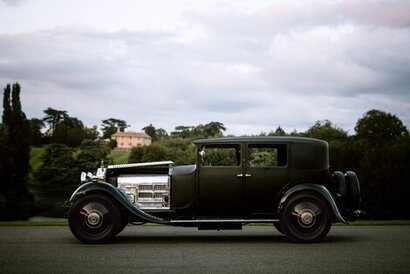
The conversion was commissioned by a private collector and the Phantom is currently making its public debut at automotive event Salon Privé, held at Blenheim Palace from today (30th August) until 2nd September.
Thought to be the most complex classic car EV conversion yet completed, the project further underlines Electrogenic’s world-leading position in this rapidly growing sector.
“We’re delighted to reveal this fabulous EV converted Phantom II to the world” said Steve Drummond, Director, Electrogenic. “It has been an immensely complicated and rewarding project, carried out over the course of 18 months by our team of sector-leading engineers, programmers and fabricators. This is undoubtedly the most complex classic car EV conversion yet attempted, the stunning results really are a testament to the world-leading talents of our team. We’re immensely proud of the results, and we’re delighted to be unveiling it at Salon Privé, here at Blenheim Palace. It’s the perfect place to reveal such a stately piece of British motoring history, now updated and future-proofed for the next hundred years of clean, silent electric motoring.”
Electrogenic, also known for its range of revolutionary ‘drop-in’ EV conversion kits for popular models – offered via an international partner-installer network – has sympathetically modernised this piece of British motoring history. One of just 1,681 Phantom IIs crafted between 1920 and 1935, it now packs a powerful electric powertrain, featuring Electrogenic’s proprietary EV technology. The Phantom’s stunning original looks and features have been retained, and as with all of Electrogenic’s projects, the conversion is entirely reversible.
The car was originally powered by a 7.7-litre pushrod straight-six, producing between 40 and 50bhp, bolted directly to a four-speed, non-synchromesh manual gearbox. In its standard configuration Rolls-Royce claimed a top speed of ‘well over 80mph’. Now, the petrol engine and gearbox have been carefully removed, replaced by 93kWh of batteries which have been carefully integrated into the existing structure of the car.
The batteries feed an electric motor mounted between the chassis rails via a custom single-speed direct drive transmission, delivering 150kW and 310Nm of torque to the fixed reduction gear, which in turn delivers 1,000Nm to the prop shaft. The systems are all seamlessly linked and managed by a bespoke suite of software - all developed in house by Electrogenic’s software engineers.
As with every Electrogenic conversion, the battery configuration has been tailored specifically to the model in question; housed within the car’s original architecture, no modifications are made to the structure itself. Electrogenic leads the world with its flexible battery installation systems.
It’s a carefully honed process which involves carrying out a 3D scan of the car’s structure, before rendering the optimal battery instillation setup in CAD. Thanks to its market leading battery installation capabilities, Electrogenic can precisely configure the batteries to fit the existing shape of the car, making the most of the useable space, and in turn, maximising battery capacity.
In the case of the Phantom II, Electrogenic has made use of the sizeable space vacated by the engine and gearbox, installing the batteries under the bonnet and between the chassis rails.
The batteries themselves are housed beneath a gleaming, hand-formed and hand-riveted aluminium cowling. The ornate casing has been designed by Electrogenic and constructed by the technicians at Auto Historica, affiliated with the Heritage Skills Academy at Bicester Heritage – an educational centre attended by Electrogenic’s apprentices, that is committed to giving young mechanics the professional skills to succeed in the heritage industry and preserve these machines for future generations.
There were a number of challenges associated with sympathetically converting a near hundred-year-old, idiosyncratic luxury motor car to run on the latest EV technology.
One key challenge was devising a way to preserve and update the Phantom’s centralised, entirely mechanical, ‘through-flow’ chassis lubrication system. This is a setup that sends oil to the car’s many phosphor-bronze bushes for brake and suspension linkages, as well as other mechanical control systems - crucial to the Rolls’ trademark silken drive. The complex system was disrupted by the removal of the straight-six engine and so Electrogenic supplemented its design to ensure it continued to work as intended.
Another challenge the team faced was re-designing the original cable-operated braking system to work seamlessly with the updated EV architecture. The original brake pedal and levers sat under the bulkhead in space now taken by the large battery pack, so Electrogenic again supplemented the design of the braking system to fit the new layout. The team re-positioned the original brake levers and cables – maintaining the original ratios of the mechanical balancing system, just in a new configuration.
The brakes are operated by a new pedal, with braking power amplified by a new hydraulic system installed between the new pedal and the original cable actuators. As a final touch, the Electrogenic team calibrated the brakes to work in tandem with the motor’s regen function, further enhancing braking performance while also boosting efficiency and range.
For additional information:

